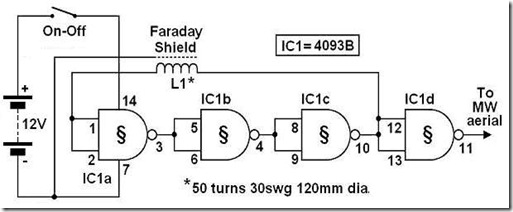The circuit shown must represent the limits of simplicity for a metal detector. It uses a single 4093 quad Schmitt NAND IC and a search coil -- and of course a switch and batteries. A lead from IC1d pin 11 needs to be attached to a MW radio aerial, or should be wrapped around the radio. If the radio has a BFO switch, switch this ON.
Since an inductor resists rapid changes in voltage (called reactance), any change in the logic level at IC1c pin 10 is delayed during transfer back to input pins 1 and 2. This is further delayed through propagation delays within the 4093 IC. This sets up a rapid oscillation (about 2 MHz), which is picked up by a MW radio. Any change to the inductance of L1 (through the presence of metal) brings about a change to the oscillator frequency. Although 2 MHz is out of range of the Medium Waves, a MW radio will clearly pick up harmonics of this frequency.
The winding of the coil is by no means critical, and a great deal of latitude is permissible. The prototype used 50 turns of 22 awg/30 swg (0.315 mm) enamelled copper wire, wound on a 4.7"/120 mm former. This was then wrapped in insulation tape. The coil then requires a Faraday shield, which is connected to 0V. A Faraday shield is a wrapping of tin foil around the coil, leaving a small gap so that the foil does not complete the entire circumference of the coil. The Faraday shield is again wrapped in insulation tape. A connection may be made to the Faraday shield by wrapping a bare piece of stiff wire around it before adding the tape. Ideally, the search coil will be wired to the circuit by means of twin-core or figure-8 microphone cable, with the screen being wired to the Faraday shield.
The metal detector is set up by tuning the MW radio to pick up a whistle (a harmonic of 2 MHz). Note that not every such harmonic works best, and the most suitable one needs to be found. The presence of metal will then clearly change the tone of the whistle. The metal detector has excellent stability, and it should detect a large coin at 80 to 90 mm, which for a BFO detector is relatively good. It will also discriminate between ferrous and non-ferrous metals through a rise or fall in tone.

No comments:
Post a Comment